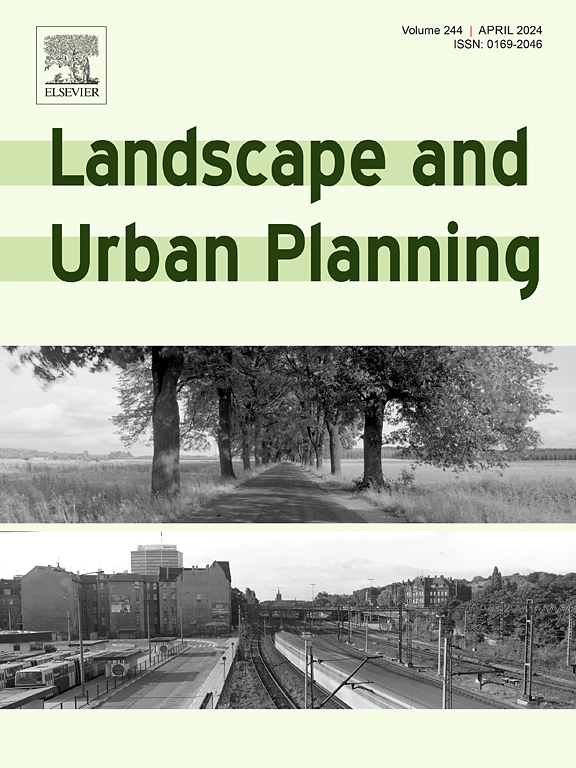Accessible, and culturally responsive: Why we need to examine diverse plant uses and values in green infrastructure
IF 7.9
1区 环境科学与生态学
Q1 ECOLOGY
引用次数: 0
Abstract
As green infrastructure (GI) proliferates as an adaptation strategy to living with increasing temperatures in urban areas, these initiatives may impact how people differentially experience the local climate and health benefits of urban greening. Scholars have studied the uneven distribution of urban greenery, but less attention has been paid to diverse plant uses and values by different sectors of the population and how those align (or not) with institutional plant preferences enshrined in GI policies. To address this gap, this article offers an in-depth case study of publicly-funded residential raingardens in a semi-arid city of the U.S. Southwest by drawing on an environmental justice framework. Through a mixed-methods approach we identify key criteria for residential plant selection among two groups from different economic and cultural backgrounds, and examine the desired benefits driving those preferences. More saliently, we found that plant preferences among low-income Hispanic residents tended to be at odds with institutional expectations of appropriate vegetation for GI installations in the context of increased heat and reduced water resources. Instead, they favored often-thirsty fruit bearing plants that provide cultural ecosystem services but are consistently excluded from the recommended plant lists used by program managers and expert practitioners. As practitioners and policy-makers seek to develop GI in historically underserved neighborhoods to reduce vulnerabilities to extreme heat, it is paramount to understand what people care to plant, what desired benefits they seek from those plants, and how they relate to plants in GI installations. Thus, this article argues that systematic attention to diversity in people-plant interactions is critical for implementing GI programs that are not only spatially, administratively, and financially accessible to underserved communities, but also culturally responsive to community identified needs. Moreover, by systematically documenting how different groups of people interact, use, and value vegetation this research adds to the movement towards integrating a biocultural approach to urban greening and to GI planning and implementation more specifically.
可及性和文化响应性:为什么我们需要研究绿色基础设施中植物的不同用途和价值
随着绿色基础设施(GI)作为一种适应城市地区气温上升的策略而激增,这些举措可能会影响人们如何以不同的方式体验当地气候和城市绿化的健康益处。学者们研究了城市绿化的不均匀分布,但很少关注不同人群对植物的不同利用和价值,以及这些利用和价值如何与地理标志政策中体现的制度性植物偏好相一致(或不一致)。为了解决这一差距,本文通过借鉴环境正义框架,对美国西南部一个半干旱城市的公共资助住宅雨花园进行了深入的案例研究。通过混合方法,我们确定了来自不同经济和文化背景的两个群体选择住宅植物的关键标准,并检查了驱动这些偏好的预期收益。更明显的是,我们发现,在热量增加和水资源减少的背景下,低收入西班牙裔居民的植物偏好往往与制度对GI装置适当植被的期望不一致。相反,他们倾向于提供文化生态系统服务的经常口渴的结果植物,但一直被排除在项目经理和专家从业者使用的推荐植物清单之外。当从业者和政策制定者寻求在历史上服务不足的社区发展地理标志以减少对极端高温的脆弱性时,了解人们关心的植物是什么,他们希望从这些植物中获得什么好处,以及他们如何与地理标志装置中的植物联系起来是至关重要的。因此,本文认为,系统地关注人与植物相互作用的多样性对于实施地理标志项目至关重要,这些项目不仅在空间上、行政上和经济上能够为服务不足的社区所接受,而且在文化上也能响应社区确定的需求。此外,通过系统地记录不同人群如何相互作用、利用和重视植被,本研究促进了将生物文化方法整合到城市绿化和更具体的地理标志规划和实施中的运动。
本文章由计算机程序翻译,如有差异,请以英文原文为准。
求助全文
约1分钟内获得全文
求助全文
来源期刊

Landscape and Urban Planning
环境科学-生态学
CiteScore
15.20
自引率
6.60%
发文量
232
审稿时长
6 months
期刊介绍:
Landscape and Urban Planning is an international journal that aims to enhance our understanding of landscapes and promote sustainable solutions for landscape change. The journal focuses on landscapes as complex social-ecological systems that encompass various spatial and temporal dimensions. These landscapes possess aesthetic, natural, and cultural qualities that are valued by individuals in different ways, leading to actions that alter the landscape. With increasing urbanization and the need for ecological and cultural sensitivity at various scales, a multidisciplinary approach is necessary to comprehend and align social and ecological values for landscape sustainability. The journal believes that combining landscape science with planning and design can yield positive outcomes for both people and nature.
 求助内容:
求助内容: 应助结果提醒方式:
应助结果提醒方式:


